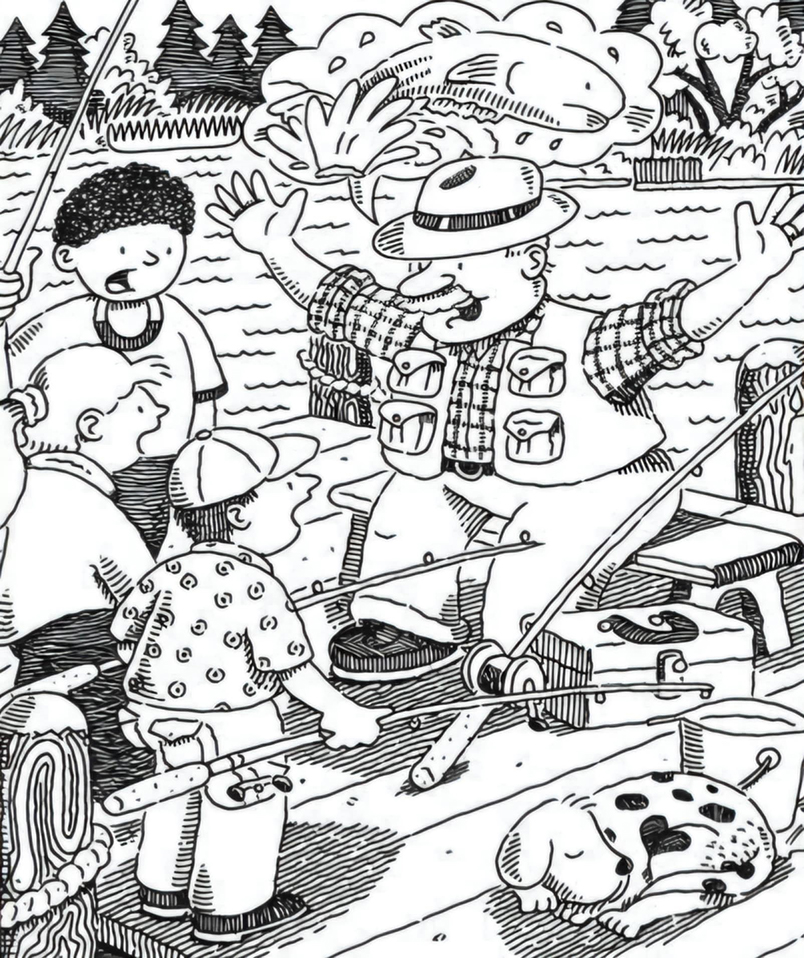Hooked on Learning: How Family Fishing Trips Build Memories and Teach Lifelong Skills
Nothing sparks childhood wonder like watching Dad’s eyes light up as he reels in the big one—literally. Picture a friendly angler on a sunlit dock, arms raised in triumph, sharing his fishing rod secrets with three rapt kids. A faithful dog snoozes at their feet while gear—tackle boxes, rods, and a coiled sleeping mat—hint at adventures past. Above the fisherman’s head, a thought bubble brims with the image of a leaping trout, symbolizing goals and dreams yet to be caught. This scene isn’t just about fish; it’s about patience, curiosity, and quality family time. Ready to cast your own line into the waters of memory-making? Let’s dive in.

Why Fishing Is More Than Just a Catch
Fishing teaches lessons that reach far beyond the water’s edge. Here’s what makes it such a powerful family activity:
- Patience and Perseverance: Waiting for a nibble builds resilience—kids learn that not every cast yields a catch but that persistence pays off.
- Nature Appreciation: Gazing at rippling water, spotting a heron on the shore, or feeling a cool breeze cultivates mindfulness and respect for the environment.
- Practical Life Skills: From knot-tying to safe hook handling, children pick up real-world abilities that boost confidence.
- Bonding Moments: Between casting lines and sharing snacks, parents and kids collect inside jokes and quiet smiles that strengthen their relationship.
By framing fishing as a holistic learning experience, you create memories and skills that outlast any single day on the dock.
Choosing the Right Gear for Young Anglers
No need to break the bank—focus on simplicity and safety when outfitting little fishers:
- Child-Sized Rods & Reels: Lightweight combos (often 4–5 feet long) fit small hands and reduce fatigue.
- Barbless Hooks: Easier to remove and kinder to curious fingers, barbless hooks minimize mishaps.
- Floats & Bobbers: Brightly colored bobbers give visual feedback—kids see action when the float dips, making learning instant and fun.
- Tackle Box Essentials: Keep things simple: a few extra lines, split shot weights, a pair of pliers, and a compact first-aid kit.
- Life Jackets & Sun Protection: Always prioritize safety—PFDs are nonnegotiable for dock or boat fishing, along with hats, sunglasses, and reef-safe sunscreen.
Arming young anglers with age-appropriate gear sets them up for success and snag-free adventures.

Picking the Perfect Fishing Spot
Where you drop a line shapes the entire experience. Consider these family-friendly locales:
- Local Piers & Docks: Easy access, built-in benches, and railings make learning comfortable. Plus, if you do hook “the big one,” you can simply walk it ashore.
- Calm Lakes and Ponds: Shallow inlets often harbor panfish—sunfish, bluegill, and crappie—which readily bite bait and delight first-timers.
- Slow-Moving Rivers: Look for deep pools behind rocks or logs where bass and trout like to lurk. The gentle current adds challenge without overwhelm.
- Managed Fishing Ponds: Many park districts stock these waters and even offer educational programs, perfect for guided introduction days.
Scout your venue in advance, noting restroom access, shade availability, and any required fishing licenses or permits.
Mastering the Basics: Simple Techniques for Kid-Friendly Success
Teaching methodical steps helps kids feel accomplishment from cast one:
- Casting 101: Demonstrate the “overhand” cast—rod tip low, elbow high, and a gentle forward flick. Let them practice with a weighted practice plug or even on dry land first.
- Baiting the Hook: Use dough balls, worms, or simple corn kernels—whatever local fish favor. Show how to thread the bait securely without squashing it.
- Reading the Bobber: Explain that a slight bob or sudden dive means “nibble” and prompt them to lift the rod tip to set the hook.
- Reeling Techniques: Teach slow, steady turns of the reel handle—no jerky motions. Encourage a rhythmic mantra: “Straighten, reel, repeat.”
- Catch-and-Release Ethics: If you practice catch-and-release, demonstrate quick, gentle handling and why care helps fish populations thrive.
Breaking down each step into fun mini-lessons makes the whole process approachable—and celebrates every little victory.

Turning Teachable Moments into Lasting Lessons
Fishing trips are ripe for “teachable seconds” that stick:
- Science in Action: Discuss life cycles of fish—eggs, fry, adult—and spot aquatic insects or plants that indicate water health.
- Math on the Dock: Count fish caught, measure their length against a small ruler, or calculate the time between bites to reinforce numeracy.
- Storytelling & Folklore: Share local fishing legends—like the “one that got away”—or teach simple rhyme schemes about water and wildlife to spark creativity.
- Environmental Stewardship: Show how to pick up litter, recycle bait containers, and leave no trace—connecting enjoyment of nature with responsibility.
These organic lessons flow naturally from action, making learning feel like part of the fun rather than a chore.

Safety First: Keeping Everyone Secure and Comfortable
A safe outing is an enjoyable outing. Key precautions include:
- Constant Supervision: Always watch little ones near water. Assign an adult “water buddy” to each child.
- Proper Footwear: Non-slip water shoes prevent tumbles on damp docks and slippery rocks.
- Weather Awareness: Check forecasts—pack rain jackets for sudden showers or extra layers for cool dawn fishing.
- Hydration & Snacks: Keep a cooler stocked with water, juice, fruit, and easy finger foods like granola bars to maintain energy.
By weaving safety into every step, you create an environment where kids can explore boldly—yet wisely.
Wrapping Up the Day: Celebrate with a Fish Fry or Picnic
Nothing caps a fishing adventure like sharing the catch of the day (if regulations allow) or celebrating with a lakeside picnic:
- Simple Fish Recipes: Teach kids to filet panfish or clean trout under adult guidance, then dust with seasoned flour and pan-fry for a fresh taste of their success.
- Catch-and-Release Option: If you’re practicing C&R, reward effort with grilled hot dogs, marshmallow s’mores by a campfire, or a storytelling circle.
- Memory Keepsakes: Press a small fin print into clay, snap photos of proud smiles, or jot down the day’s highlights in a shared “Fishing Log” journal.
These rituals reinforce the day’s lessons, ensuring the thrill of that leaping trout lives on well after you leave the dock.

Conclusion: Casting Forward into New Adventures
That animated scene—kids clustered around an excited fisherman, eyes wide as trout dreams swirl overhead—captures the magic that unfolds when families cast lines together. More than just a recreational pastime, fishing fosters patience, teaches ecological respect, and knits generations closer with shared stories and laughter. So grab your rods, pack those bobbers and snacks, and head to your nearest dock, lake, or riverbank. The next big catch might just be a moment you’ll treasure forever. Tight lines and happy memories await!





